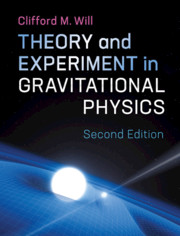Book contents
- Frontmatter
- Dedication
- Contents
- Preface
- Acknowledgments
- 1 Introduction
- 2 The Einstein Equivalence Principle
- 3 Gravitation as a Geometric Phenomenon
- 4 The Parametrized Post-Newtonian Formalism
- 5 Metric Theories of Gravity and Their Post-Newtonian Limits
- 6 Equations of Motion in the PPN Formalism
- 7 The Classical Tests
- 8 Tests of the Strong Equivalence Principle
- 9 Other Tests of Post-Newtonian Gravity
- 10 Structure and Motion of Compact Objects
- 11 Gravitational Radiation
- 12 Strong-Field and Dynamical Tests of Relativistic Gravity
- References
- Index
2 - The Einstein Equivalence Principle
Published online by Cambridge University Press: 07 September 2018
- Frontmatter
- Dedication
- Contents
- Preface
- Acknowledgments
- 1 Introduction
- 2 The Einstein Equivalence Principle
- 3 Gravitation as a Geometric Phenomenon
- 4 The Parametrized Post-Newtonian Formalism
- 5 Metric Theories of Gravity and Their Post-Newtonian Limits
- 6 Equations of Motion in the PPN Formalism
- 7 The Classical Tests
- 8 Tests of the Strong Equivalence Principle
- 9 Other Tests of Post-Newtonian Gravity
- 10 Structure and Motion of Compact Objects
- 11 Gravitational Radiation
- 12 Strong-Field and Dynamical Tests of Relativistic Gravity
- References
- Index
Summary
We discuss the foundations of general relativity and all modern gravitational theories, based on the Einstein Equivalence Principle (EEP). We show that this principle is the basis for all metric theories of gravity including general relativity, in which gravity is a consequence of spacetime geometry. We review experimental test of the three pieces of EEP, the Weak Equivalence Principle, Local Lorentz Invariance and Local Position Invariance, and describe a number of general theoretical frameworks used to analyse EEP and its consequences.
Keywords
- Type
- Chapter
- Information
- Theory and Experiment in Gravitational Physics , pp. 11 - 60Publisher: Cambridge University PressPrint publication year: 2018

